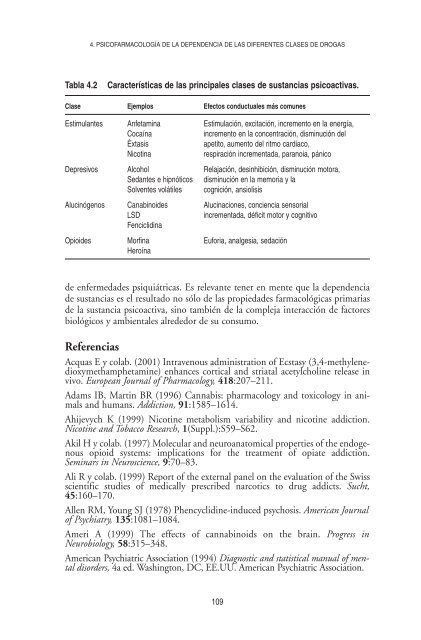Neurociencia del consumo y dependencia de sustancias psicoactivas
Neurociencia del consumo y dependencia de sustancias psicoactivas
Neurociencia del consumo y dependencia de sustancias psicoactivas
You also want an ePaper? Increase the reach of your titles
YUMPU automatically turns print PDFs into web optimized ePapers that Google loves.
4. PSICOFARMACOLOGÍA DE LA DEPENDENCIA DE LAS DIFERENTES CLASES DE DROGAS<br />
Tabla 4.2 Características <strong>de</strong> las principales clases <strong>de</strong> <strong>sustancias</strong> <strong>psicoactivas</strong>.<br />
Clase Ejemplos Efectos conductuales más comunes<br />
Estimulantes Anfetamina Estimulación, excitación, incremento en la energía,<br />
Cocaína incremento en la concentración, disminución <strong><strong>de</strong>l</strong><br />
Éxtasis apetito, aumento <strong><strong>de</strong>l</strong> ritmo cardiaco,<br />
Nicotina respiración incrementada, paranoia, pánico<br />
Depresivos Alcohol Relajación, <strong>de</strong>sinhibición, disminución motora,<br />
Sedantes e hipnóticos disminución en la memoria y la<br />
Solventes volátiles cognición, ansiolisis<br />
Alucinógenos Canabinoi<strong>de</strong>s Alucinaciones, conciencia sensorial<br />
LSD incrementada, déficit motor y cognitivo<br />
Fenciclidina<br />
Opioi<strong>de</strong>s Morfina Euforia, analgesia, sedación<br />
Heroína<br />
<strong>de</strong> enfermeda<strong>de</strong>s psiquiátricas. Es relevante tener en mente que la <strong><strong>de</strong>pen<strong>de</strong>ncia</strong><br />
<strong>de</strong> <strong>sustancias</strong> es el resultado no sólo <strong>de</strong> las propieda<strong>de</strong>s farmacológicas primarias<br />
<strong>de</strong> la sustancia psicoactiva, sino también <strong>de</strong> la compleja interacción <strong>de</strong> factores<br />
biológicos y ambientales alre<strong>de</strong>dor <strong>de</strong> su <strong>consumo</strong>.<br />
Referencias<br />
Acquas E y colab. (2001) Intravenous administration of Ecstasy (3,4-methylenedioxymethamphetamine)<br />
enhances cortical and striatal acetylcholine release in<br />
vivo. European Journal of Pharmacology, 418:207–211.<br />
Adams IB, Martin BR (1996) Cannabis: pharmacology and toxicology in animals<br />
and humans. Addiction, 91:1585–1614.<br />
Ahijevych K (1999) Nicotine metabolism variability and nicotine addiction.<br />
Nicotine and Tobacco Research, 1(Suppl.):S59–S62.<br />
Akil H y colab. (1997) Molecular and neuroanatomical properties of the endogenous<br />
opioid systems: implications for the treatment of opiate addiction.<br />
Seminars in Neuroscience, 9:70–83.<br />
Ali R y colab. (1999) Report of the external panel on the evaluation of the Swiss<br />
scientific studies of medically prescribed narcotics to drug addicts. Sucht,<br />
45:160–170.<br />
Allen RM, Young SJ (1978) Phencyclidine-induced psychosis. American Journal<br />
of Psychiatry, 135:1081–1084.<br />
Ameri A (1999) The effects of cannabinoids on the brain. Progress in<br />
Neurobiology, 58:315–348.<br />
American Psychiatric Association (1994) Diagnostic and statistical manual of mental<br />
disor<strong>de</strong>rs, 4a ed. Washington, DC, EE.UU. American Psychiatric Association.<br />
109

















